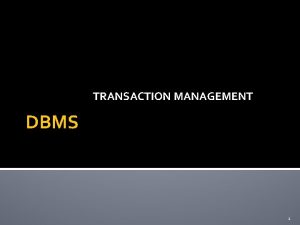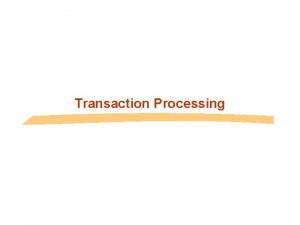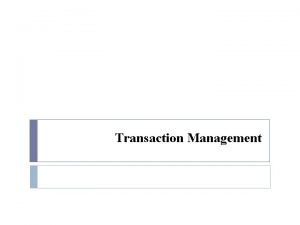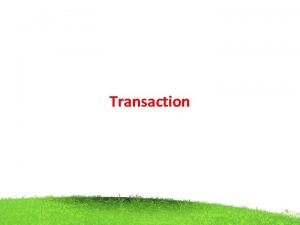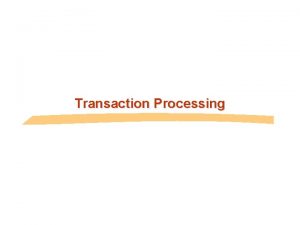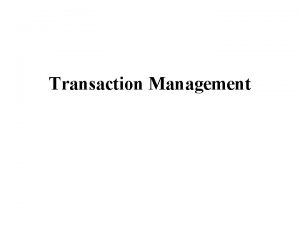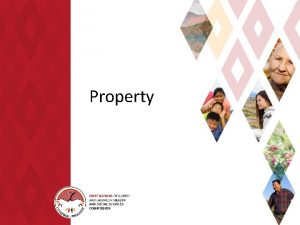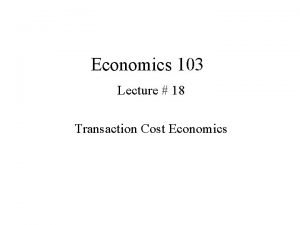Resources and Transaction Cost How Property Rights Economics











- Slides: 11

Resources and Transaction Cost: How Property Rights Economics Furthers the Resource-based View Foss, Kirsten and Foss, Nicolai J. (2005) SMJ, 26: 541 -553 Yuju Tu

Introduction Ronald Coase: ”…economic activity is designed to accomplish what high transaction costs would otherwise prevent” This paper investigates the relations between transaction costs, and value creation and value appropriation, relating to the RBV, from a view of EPR This paper’s findings help explain how value can be created by reducing transaction cost, and brings attention to ways of appropriating value beyond bargaining

De. Beers Case De. Beers provides customer with only a packet of roughly-sorted stones, generally corresponding to customer’s wishes. This is offered on a “take-it-or-leave-us” basis. Does De. Beers’ strategy reflect raw market power? No. Actually De. Beers’ practice effectively eliminates the transaction cost by minimizing the effort spent on sorting and negotiating. Thus, this practice maximizes the value for both De. Beers and its customer.

Resources as Bundles of Property Rights Resources as bundles of property rights : An aggregation view. It is useful to think of resources as bundles of property rights to attributes. Resources are not simply the elementary and irreducible particles. Thinking of resources in terms of property rights to valued attributes implies that resources are not given, but are the outcomes of process of economizing transactions

Resource Value, Transaction Cost, and Property Right Protection From the property right view, transaction costs can influence the resource value. For example, while the resource owner protects its right from being captured by other non-owner, additional transaction cost might thus derive and have impact this resource value. Sometimes, it is too costly to exclude nonowners from all possible uses of resources

Resource Value, Transaction Cost, and Property Right Protection (cont. ) The Resource Base View considers only imitation protection in terms of property right. However, there is way much effort to prevent from property right capture by non-owner in real world, such as moral hazard, holdup, adverse-selection. Thus, attempts to maximize resource value must take such transaction costs into account

Relating Transaction Costs to Value Creation and Appropriation – The Zero Transaction Cost Situation Coase: all value can be created from the exchange and use of goods, when transaction cost is absent. Analogously, when cost of exchanging property right is zero, the resource will be put to its best possible uses to maximize value creation. The value creation is independent of value distribution, when transaction cost is zero, as well as when there is an costless bargaining

Relating Transaction Costs to Value Creation and Appropriation – The Positive Transaction Cost Situation Resource value will be eroded because of EPRbased value dissipation, ex: the direct value dissipation about property right protection and capture, and indirect value dissipation including hindered value-creating exchange, moral hazard, and holds-up. Also, unowned resource will erode resource value, ex: a firm’s transportation advantage derived from a unique riverside location might be decreased, because other firms somewhere using the same river cause traffic congestion

Transaction Costs And Sustained Competitive Advantage: Heterogeneity: RBV emphasizes inherent resources efficiencies and complementarities. EPR view can supplement RBV: value of different resources (creation and appropriation) could be influenced, because of the transaction costs resulting from property right protection.

Transaction Costs And Sustained Competitive Advantage: Competition Barriers to ex-ante composition: RBV stresses informational barriers. BPR focuses on barrier resulting from costly measurement. BPR can broaden RBV on ex-post competition: Not only imitation but also moral hazard, reverse-selection, holds-up, and etc.

Conclusion Strategic opportunities arise from reducing transaction cost Thus, EPR can significantly contribute to the RBV by providing a more refined understanding on value creation and appropriation in terms of property right protection cost
 Positive vs negative rights
Positive vs negative rights Duties towards self
Duties towards self Legal rights and moral rights
Legal rights and moral rights Positive rights and negative rights
Positive rights and negative rights Recoverability adalah
Recoverability adalah Maastricht university school of business and economics
Maastricht university school of business and economics What is transformation process
What is transformation process Difference between fixed and variable resources
Difference between fixed and variable resources Sapratibandha daya and apratibandha daya
Sapratibandha daya and apratibandha daya Chemical properties of citric acid
Chemical properties of citric acid Littoral rights real estate
Littoral rights real estate Negative right
Negative right




